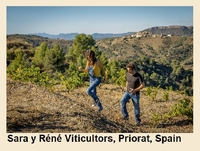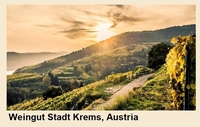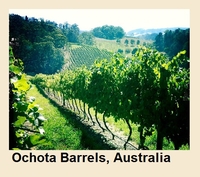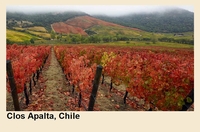Looking back on 2020, there have been countless ways in which a wine writer's work has changed. One such challenge has been the inability to travel internationally to various wine regions for research. These opportunities offer a unique immersion into the culture, geography, history, and of course, wines of a particular place. Sure, it's always fun to go somewhere new, but I think I may have taken for granted just how impactful these experiences were in shaping a perspective on a place. From winemaker and grape grower personalities to the significance of culture and cuisine in relationship to the regional wines, and simply seeing the soils and the terrain—these are all elements that make for a more profound understanding of place that helps better tell a story.
Looking ahead to 2021, it doesn't appear as though travel will be back on the docket any time soon. But just as we have all had to adjust to a new way of working, my goal for 2021 is to continue to experience the world of wine by diving into regions I have yet to explore. And though I may not be able to do it in person, I can still focus my attention in a more intentional way. Sure, I may not get a stamp in my passport for the effort, but it beats TSA lines and cramped trans-Atlantic flights. This time, instead of letting a place lead me to the wine, I'll let the wine lead me to the place. Drawing upon wines I've tasted recently, I've fashioned a sort of Resolution List of wine regions I'd like to get to know a little better.
Priorat (Catalonia, Spain)
Priorat tops my list as a must-see. If not for the steep, hillside vineyards of head-trained Garnacha and Cariñena, then for the intense, sun-baked wines for which it celebrated.

Myriad producers have already laid the groundwork for this region's iconic status—Scala Dei, Ferrer Bobet, Alvaro Palacios, Clos Mogador, and Mas Martinet are a few that come to mind. But my curiosity about the region was renewed with the 2018 Sara y Réné Viticultors Partida Pedrer.
A joint venture by Priorat power couple Sara Pérez of Mas Martinet and Réné Barbier of Clos Mogador, this wine is part of a limited portfolio derived from a small, sloping vineyard of old-vine Garnacha and Cariñena that the two have revitalized through organic farming. This particular wine is 100% Garnacha that has been aged in clay pots resulting in a palate that is as fresh and lively as it is rich in concentrated red and black fruit. Added structure from uncrushed, whole-berry vinification gives this wine a delightful texture, and the extended skin maceration delivers a peppery complexity.
Austria
I've always been fascinated by Austria. The mountains, the cuisine (hello, schnitzel!), the architecture, the wine…there's a fairy tale allure about it that has long kept made it a top region to explore. In recent years, it seems Austria's wines have enjoyed a bit of the spotlight among trendy wine enthusiasts looking for cool climate, lower-alcohol styles. But, I would argue that Austrian wine has been on a steady rise to top-tier status that will long outlast a fleeting trend.
I'll be honest, Zweigelt is my go-to summer wine. For this Texas native, it checks all the boxes on concentrated fruitiness and juicy structure, without too much heft. It was the 2013 Meinklang Zweigelt that made me a convert once and for all. From Austria's eastern Burgenland region, this biodynamic producer is a family-owned farming operation including a herd of black Angus cattle that help with the vineyard's composting needs. Through low-intervention winemaking techniques, I remember this wine as being alive with notes of spiced cranberries and earthy mushrooms. The palate was light, playful, and remarkably memorable.

But I'm also pretty taken with Grüner Veltliner. While it generally makes an excellent crisp, clean white that's budget-friendly and pairs perfectly with spring salads, upon tasting a few of them side by side, there's a lot more to Grüner than meets the eye. The 2019 Kremstal Andres Harm Weingut recently piqued my interest. From a vineyard site that straddles the border between Wachau and Kremstal, this struck me as an elegant and striking example of the grape's versatility and depth. It is bright and refreshing with notes of lime, white pepper, and bay leaf, and a long, mineral-driven finish.
Australia
Truthfully, when it comes to wine, Australia has always been a bit overwhelming for me. Not only is the country a sprawling continent with distinct wine-growing regions spread out over miles and miles of geography, but also because opportunities to taste the wines from regions such as the Yarra Valley, Mornington Peninsula, and Margaret River are relatively limited. As a result, it's a struggle to get a solid perspective on what's happening in the land down under.

One wine that has inspired me to dig a little deeper is the 2018 Ochota Barrels "I Am the Owl" Syrah from Adelaide Hills. Perhaps this inspiration is even more profound due to the recent passing of celebrated winemaker Taras Ochota. Known for his magnetic personality and for championing natural winemaking practices, Ochota left an indelible mark on the Australian wine industry. This particular wine is a pristine example of the legacy he left behind. With punchy vibrancy on the palate from elevated acidity, this wine offers notes of red fruit, black pepper, and a light, easy palate structure that becomes more enjoyable with each sip.
Chile
Not many wine growing regions can claim geography squeezed along a narrow corridor bound by the ocean and a towering mountain range. Yet, the distinctive growing regions of Chile are so diverse depending on their proximity to either the Pacific Ocean or the Andes mountains. Many have come to associate Chile with inexpensive Cabernet Sauvignon and Carménère, but there are ample examples of premium wines made with exceptional quality and finesse.

A case in point is the recently released 2017 La Postolle Clos Apalta. This blend of Carménère, Cabernet Sauvignon, Merlot, and Petit Verdot marks the 20th Anniversary of the Marnier Lapostolle family's foundational impact in establishing the Apalta Valley as a quality wine region. Deep and inky in color, this wine is brawny with notes of ripe raspberry and red currant and a lush, soft palate that finishes with blackberry, licorice, and hints of black olive.
But Chile isn't just a one-trick-pony. If you look beyond the Cabernet and Carménère, you can find Pinot Noir and Sauvignon Blanc as well as Carignan and País. A few months ago, I had a chance to taste the 2018 Terranoble Gran Reserva Carignan, a wine crafted from grapes grown on 60-100-year-old vines. I was struck by its elegance and finesse with alluring floral aromas backed by notes of black cherry, pomegranate, dried and savory herbs. This wine balances freshness and complexity, offering a smooth, velvety finish.
Beyond a curiosity for Chilean Carignan, I'd like to know more about Paìs. Likely the first form of Vitis vinifera brought over to the Americas by Spanish missionaries in the 16th Century. The variety traces its origin back to the Spanish Listan Prieto (Listan Negro). It made its way to North American with the name Mission and is known in other parts of South America as Criolla and Cereza. Known for its easy, quenchy, fruit-forward palate, Paìs has often been compared to Gamay and lighter styles of Pinot Noir.
Particularly intriguing is the 2018 J Bouchon Paìs Salvaje. Spanish for "wild," Salvaje is aptly named for the wild vineyard that grows, untamed into the canopies of trees nearby. This delightful wine offers bright notes of red cherry and ripe strawberry and lush florality leading to a touch of earthiness on the palate and a juicy, lingering finish.
We're indeed all looking for ways to see silver linings in the year ahead, even if that means taking things one day at a time. Reviewing this list of wines is a comforting reminder that there are many things to uncover about the world's various wine-growing regions. Even if an in-person visit has to wait a while, a virtual pursuit will suffice for now.